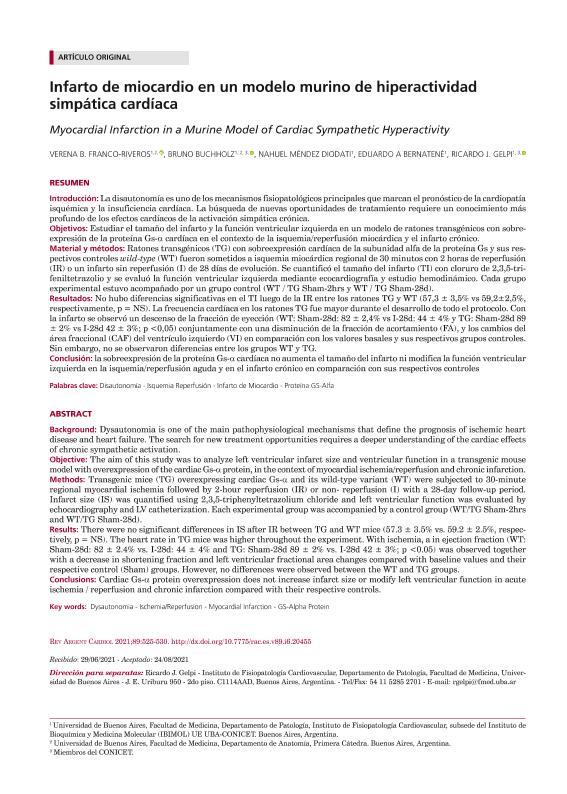Artículo
Introducción: La disautonomía es uno de los mecanismos fisiopatológicos principales que marcan el pronóstico de la cardiopatía isquémica y la insuficiencia cardíaca. La búsqueda de nuevas oportunidades de tratamiento requiere un conocimiento más profundo de los efectos cardíacos de la activación simpática crónica.Objetivo: Estudiar el tamaño del infarto y la función ventricular izquierda en un modelo de ratones transgénicos con sobreexpresión de la proteína Gs-α cardíaca en el contexto de la isquemia/reperfusión miocárdica y el infarto crónico.Material y métodos: Ratones transgénicos (TG) con sobreexpresión cardíaca de la subunidad alfa de la proteína Gs y sus respectivos controles wild-type (WT) fueron sometidos a una isquemia miocárdica regional de 30 minutos con 2 horas de reperfusión (IR) o un infarto sin reperfusión de 28 días de evolución. Se cuantificó el tamaño del infarto (TI) con cloruro de 2,3,5-trifeniltetrazolio y se evaluó la función ventricular izquierda mediante ecocardiografía y cateterismo del VI.Resultados: No hubo diferencias significativas en el TI luego de la IR entre los ratones TG y WT (57,3±3,5% vs 59,2±2,5%, respectivamente, p=NS). La FC en los ratones TG fue mayor durante todo el protocolo estudiado. Se observó un descenso de la FE (WT: Sham-28d: 82±2,4% vs I-28d: 44±4% y TG: Sham-28d 89±2% vs I-28d 42±3%; p<0,05) conjuntamente con una disminución de la FA y la CAF VI en comparación con los valores basales y sus respectivos grupos controles. Sin embargo, no se observaron diferencias entre los grupos WT y TG. Background: Dysautonomia is one of the main pathophysiological mechanisms that define the prognosis of ischemic heart disease and heart failure. The search for new treatment opportunities requires a deeper understanding of the cardiac effects of chronic sympathetic activation. Objective: The aim of this study was to analyze left ventricular infarct size and ventricular function in a transgenic mouse model with overexpression of the cardiac Gs-α protein, in the context of myocardial ischemia/reperfusion and chronic infarction. Methods: Transgenic mice (TG) overexpressing cardiac Gs-α and its wild-type variant (WT) were subjected to 30-minute regional myocardial ischemia followed by 2-hour reperfusion (IR) or non- reperfusion (I) with a 28-day follow-up period. Infarct size (IS) was quantified using 2,3,5-triphenyltetrazolium chloride and left ventricular function was evaluated by echocardiography and LV catheterization. Each experimental group was accompanied by a control group (WT/TG Sham-2hrs and WT/TG Sham-28d). Results: There were no significant differences in IS after IR between TG and WT mice (57.3 ± 3.5% vs. 59.2 ± 2.5%, respectively, p = NS). The heart rate in TG mice was higher throughout the experiment. With ischemia, a in ejection fraction (WT: Sham-28d: 82 ± 2.4% vs. I-28d: 44 ± 4% and TG: Sham-28d 89 ± 2% vs. I-28d 42 ± 3%; p <0.05) was observed together with a decrease in shortening fraction and left ventricular fractional area changes compared with baseline values and their respective control (Sham) groups. However, no differences were observed between the WT and TG groups. Conclusions: Cardiac Gs-α protein overexpression does not increase infarct size or modify left ventricular function in acute ischemia / reperfusion and chronic infarction compared with their respective controls.
Infarto de Miocardio en un modelo murino de hiperactividad Simpática Cardíaca
Título:
Myocardial Infarction in a Murine Model of Cardiac Sympathetic Hyperactivity
Franco Riveros, Verena Beatriz ; Buchholz, Bruno
; Buchholz, Bruno ; Méndez Diodati, Nahuel
; Méndez Diodati, Nahuel ; Bernatene, Eduardo Alberto
; Bernatene, Eduardo Alberto ; Gelpi, Ricardo Jorge
; Gelpi, Ricardo Jorge
 ; Buchholz, Bruno
; Buchholz, Bruno ; Méndez Diodati, Nahuel
; Méndez Diodati, Nahuel ; Bernatene, Eduardo Alberto
; Bernatene, Eduardo Alberto ; Gelpi, Ricardo Jorge
; Gelpi, Ricardo Jorge
Fecha de publicación:
12/2021
Editorial:
Sociedad Argentina de Cardiologia
Revista:
Revista Argentina de Cardiolog+ia
ISSN:
1850-3748
Idioma:
Español
Tipo de recurso:
Artículo publicado
Clasificación temática:
Resumen
Palabras clave:
DISAUTOMIA
,
INFARTO/REPERFUSIÓN
,
INFARTO DE MIOCARDIO
,
PROTEÍNA GS-ALFA
Archivos asociados
Licencia
Identificadores
Colecciones
Articulos(IBIMOL)
Articulos de INSTITUTO DE BIOQUIMICA Y MEDICINA MOLECULAR
Articulos de INSTITUTO DE BIOQUIMICA Y MEDICINA MOLECULAR
Citación
Franco Riveros, Verena Beatriz; Buchholz, Bruno; Méndez Diodati, Nahuel; Bernatene, Eduardo Alberto; Gelpi, Ricardo Jorge; Infarto de Miocardio en un modelo murino de hiperactividad Simpática Cardíaca; Sociedad Argentina de Cardiologia; Revista Argentina de Cardiolog+ia; 89; 6; 12-2021; 501-505
Compartir



